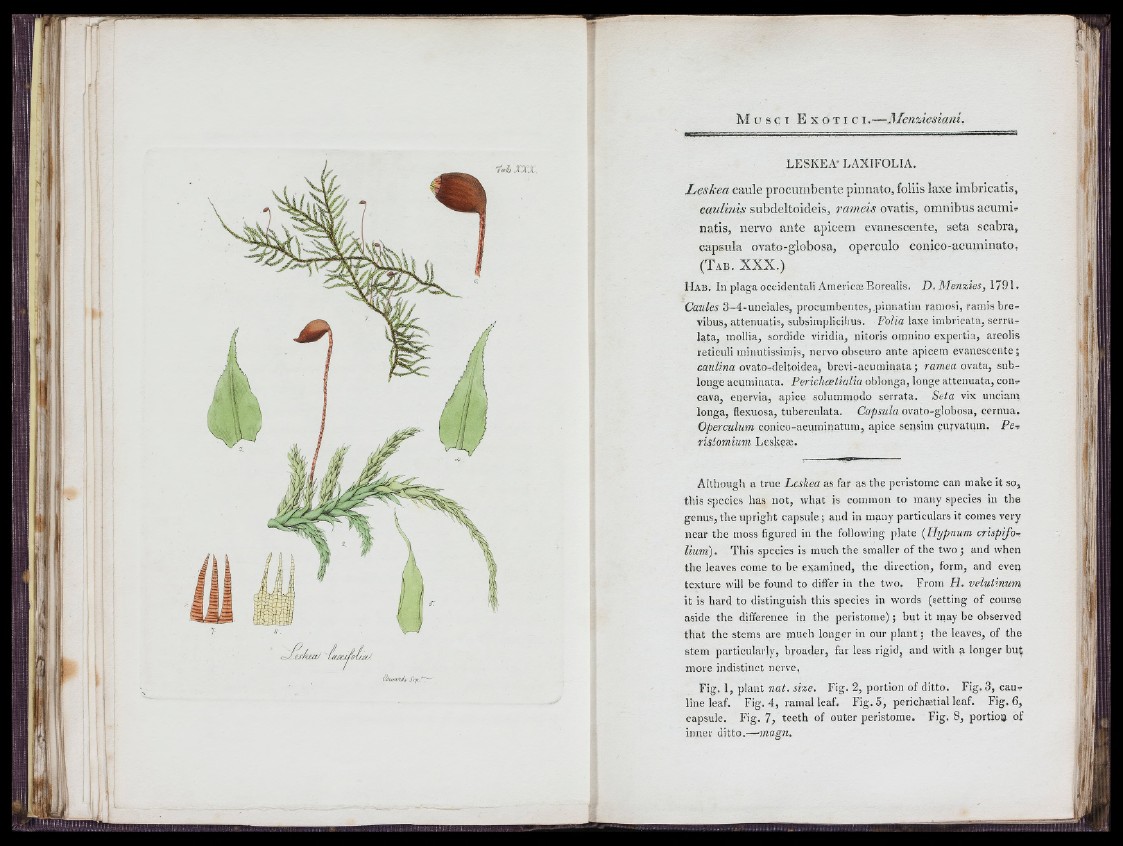
s1è1 i
: i
'
r -'í
it
■I ,1
XXX.
Sep. P
LESKEA' LAXIFOLIA.
Leskea caule procumbente pinnato, foliis laxe imbricatis,
caulinis subdeltoideis, rameis ovatis, omnibus acuminatis,
nervo ante apicem evanescente, seta scabra,
capsula ovato-globosa, operculo conico-acuminato,
( T a b . X X X .)
H a b . In p lag a occid en ta li .Americæ Borealis. D. Menzies, 17 9 1 .
Caules 3 -4 ~ u n c ia le s, p ro c um b e n te s,.p in n a tim ramosi, ramis b re -
vib u s, a tte n u a tis , subsimplicibus. Folia laxe im b ric a ta , s e rru la
ta , mollia, sordide v irid ia , n ito ris omnino e x p e rtia , areolis
re ticu li m in u tiss im is , n e rv o obscuro a n te apicem evanescente ;
caííZina o v a to -d e lto id e a , b r e v i-a c um in a ta ; ram e a o v a ta , su b longe
a c um in a ta . Perichcetialia ob lo n g a , longe a tte n u a ta , co n -
cav a , en e rv ia , ap ic e solummodo se rra ta . Seta vix unciam
lo n g a , flexuosa, tu b e rc u la ta . Capsula o v a to -g lo b o sa , c e rn u a .
Operculum co n ic o -a c um in a tum , apice sensim cu rv a tum . Pe .
rislomium Leskeæ.
Although a true Leskea as far as the peristome can make it so,
tliis species has not, what is common to many species in tlie
genus, the upright capsule; and in many particulars it comes very
near the moss figured in the following plate [Flypnum crispifo.
Hum). This species is much the smaller of the two; and when
the leaves come to be examined, the direction, form, and even
texture will be found to diflær in the two. From FL veluiinum
it is hard to distinguish this species in words (setting of course
aside the difference in the peristome) ; but it may be observed
that the stems are much longer in our plant ; the leaves, of the
stem particularly, broader, far less rigid, and with a longer but
more indistinct nerve.
Fig. 1, plant 7?a/. Jtxc. Fig. 2, portion of ditto. Fig. 3, caur
line leaf. Fig. 4, ramal leaf. F ig .5 , perichætialleaf. Fig. 6,
capsule. Fig. 7, teeth of outer peristome. Fig. 8, portion of
inner ditto.—magn.
:
1 ;
ifUP
4
I